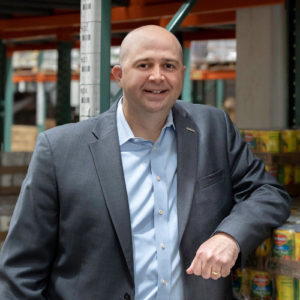Taking a page from the startup world, a growing number of food banks are carving out entrepreneurial teams and tasking them with exploring new, experimental ways to eradicate hunger.
Described variously as innovation labs, research institutes or strategy groups, the independent units recognize that traditional methods of addressing hunger have not helped the nation turn the corner on food insecurity. Their mandate is to brainstorm and bring forth evidence-based ways to solve the structural causes of hunger.
“It’s root-cause work on steroids,” said Meg Kimmel, Executive Vice President and Chief Strategy Officer at Maryland Food Bank.
Maryland Food Bank announced its Strategy Group in October, putting it in the company of a growing number of other food banks, including Vermont Food Bank, which is launching a Food Security Innovation Lab, and Connecticut Foodshare, which runs the Institute for Hunger Research & Solutions. Similarly, Northern Illinois Food Bank is staffing a new Innovation Team and Feeding America Western Michigan is building a new group for Strategic Initiatives and Partnerships.
While their specific approaches may differ, units like these share a deep regard for gathering data, piloting, testing, identifying best practices, and even failing, all in the name of making progress in the fight against hunger.

At Maryland Food Bank, the seeds for the Strategy Group began germinating before the pandemic, though some of its current work is because of it. Priorities for the group include expanding the food bank’s workforce development program, allowing people to order food through an app, and developing a cost-effective program for home delivery, which the food bank first began offering during the pandemic.
“When the pandemic hit, we all learned that we are a lot more innovative than we ever imagined,” Kimmel said. “It feels great to think that we are in the very early days of building the next generation of food bank activities and models.”
The hiring of Daniel Sturm a year ago as Vice President of Learning, Measurement and Evaluation helped to set things in motion. One of his early tasks was to review labor and job statistics to identify high-growth sectors with job opportunities that could sustain families.
“We were able to wipe the whiteboard clean and ask, ‘If your goal is to get people into family-sustaining jobs, what would that look like,’” Sturm said. Because the work is not explicitly related to food, he added, without the strategy group, “We wouldn’t have had anywhere to hold the work.”
Kimmel noted that creating a strategy group allows the team to experiment without “taking the whole food bank through trying and failing fabulously and quickly.”
Sturm’s study of labor and job statistics led the food bank to advance its workforce development program by identifying high-growth jobs, including in health care, green jobs, and commercial driving. The team then surveyed the organizations already in those spaces to determine who could partner with it to train community members. The food bank is now finalizing partners and recruiting its first cohort of trainees.
The effort expands the food bank’s workforce development programming beyond culinary training, which had been in existence for years, but was difficult to scale. “Our food work can only get as big as our kitchen,” Kimmel said. “If we create a model in partnership, then we can scale.”
The food bank’s four-person strategy group, funded by general operating funds, includes two data experts and a government liaison who focuses on research and advocacy – ensuring that the group’s work is grounded in data and amplified strategically through policy work.

Vermont Food Bank’s Food Security Innovation Lab is a $3 million, two-year venture to be staffed by two professionals with the goal of launching four pilots and scaling two of them. The result may be new programs for the food bank, or spinoff projects that become housed at a different community organization.
“We are not being prescriptive about what the pilots are, and we are not presuming to know the solutions that the lab is going to land on,” said Cassie Lindsay, Director of Strategic Giving, adding that there is no shortage of places to begin. “We have a lot of great ideas. They bubble up and percolate but sometimes don’t have a place to land on our team.”
The solutions may not even center on food, though the measure of success will be a more food-secure Vermont, said John Sayles, CEO. The lab may continue on after the initial two years, but he does not expect it to be a permanent part of the organization. Rather, it’s a way to help reshape it.
“In the past, ending hunger meant making sure food was accessible and affordable,” Sayles said. “We realized as an organization that it really is equity and solving for ending racial oppression and changing structures and systems in our society that’s going to be a long-term solution to hunger.”
The lab’s lead will report directly to Sayles, who says he “will run interference for this team to make sure they have the freedom to think differently.”
Funding for the lab draws largely from a recent gift from billionaire philanthropist MacKenzie Scott and represents a bit of a crossroads for the food bank. “It felt like we could take this moment and just become endlessly more efficient at distributing food,” Lindsay said. The alternative was to treat the gift as “our best and maybe only chance of doing the important work of changing the overall system.”
Northern Illinois Food Bank is seeking to change the overall system by broadening access to food. It is putting together a four-person Innovation Team that will draw heavily on human centered design principles to make the food bank’s My Pantry Express online ordering system more appealing to people who would benefit from it, but are not currently using it.
Greg Stopka, hired only weeks ago as the food bank’s Senior Director of Innovation, previously worked as an innovation manager in city government, where he used the same principles of design, which emphasize customer knowledge and experience. “A big part of the Innovation Team will be engaging the neighbors we are trying to help,” Stopka said.
Feeding America West Michigan also wants to reach more people in need, and plans to do so through its still-forming Strategic Initiatives and Partnerships group. At a time when traditional food pantries are fading, the food bank is looking toward new distribution models, as well as non-conventional partners, such as healthcare organizations, to broaden its reach. “We need to look at how to get food to people in need in ways we may have never thought of before,” said Kenneth R. Estelle, President and CEO.
Connecticut Foodshare has built sustainability into its plan for the Institute for Hunger Research and Solutions. Launched in 2019 and headed by Katie Martin, PhD, the Institute researches different approaches to solving hunger, while also providing training and consulting on best practices.

Its initiatives include a system that helps pantries rank the nutritional quality of the food they distribute and a framework for promoting dignity, choice and community connection via pantries. Both programs have been rolled out to food pantries across Connecticut and in other states.
Housing the Institute at the food bank allows for its research to more quickly translate into action, said Jason Jakubowski, CEO of Connecticut Foodshare. The Institute is a “clearinghouse for all of the efforts for how to eradicate hunger for the future,” he said.
Jakubowski also sees the Institute as an important springboard for initiating conversations with elected officials. “Whatever way there is to solve hunger is going to have to involve the government,” he said. “The idea that we have become a go-to for government sources, I see that as laying the groundwork for brainstorming on solutions.”
John Whitman, PhD, Instructor in Business and Nonprofit Management and a lecturer at Harvard Extension School, agreed that government intervention is necessary to ending hunger. While innovation labs may be useful for identifying new approaches, truly addressing root causes would require food banks to “shift from the organizational to the institutional, and mobilize resources for the movement it would take to change social policy,” he said.
Jakubowski said he is encouraged that more food banks are expanding their work in root causes through focused initiatives. “It is a broader acknowledgement of the fact that we are shifting paradigms in this industry,” he said. “We are moving away from the model of amassing and distributing edible products.” – Ambreen Ali
Ambreen Ali is a freelance writer and editor based in New Jersey. She was formerly an editor at SmartBrief and a congressional reporter at CQ Roll Call in Washington, D.C.
Like what you’re reading?
Support Food Bank NewsConnect with Us:










